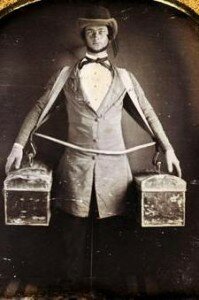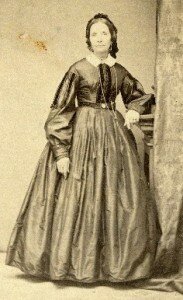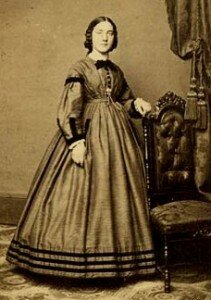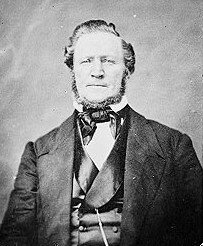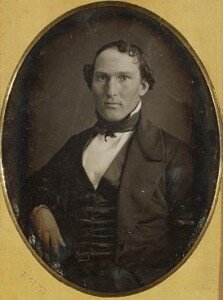Why Dress Like a Pioneer?
For a printable copy of this article, including suggested clothing charts, click Why Dress Like a Pioneer.
During the mid-19th century, members of the Church of Jesus Christ of Latter-day Saints dressed very much like their non-LDS counterparts. Their lives, too, were very much like any other life of similar location and livelihood. Their personal tests and trials may have been different from our own today, but there are many similarities, and much we can learn from their tragedies and triumphs, and most particularly, from their faith.
Dressing in historic clothing is one way to form an immediate connection to the past. When we take on their clothing, we get a better feel for the physical conditions of their lives. We step outside our own known world, and enter theirs, for just awhile, setting aside our daily worries and distractions. We can have some wonderful “time travel” moments, when it feels as though the veil is very thin, and our pioneer friends are standing right beside us, encouraging us in our personal journeys.
Not everyone wants to play pretend to the same degree of immersion, however. This dressing plan allows for multiple stages of historic clothing, from the basic flavor of the past, to a fully authentic wardrobe. By setting an expectation of participation at the basic level or above, a variety of personal preferences and budgets can be accommodated without compromising the “time travel” moments of those who prefer a more immersive experience. Continue reading
Make Drawers for Women
For a printable PDF of this project, click Make Drawers for Women.
Drawers are an optional garment for your pioneer or emigrant wardrobe 1840 to 1865, as not all women of the mid-19th century wore them. (If you use a cage or hoop, wear drawers; the handcart era is pre-hoop.)
Mid-century women’s (and teen girl’s) drawers have an open crutch seam to facilitate bathroom use; however, there is significant overlap and generous fabric around the hips; this is a very modest garment as a result. Wearing drawers over the modern temple garment is optional, as they serve a similar purpose: they make long walking a lot more comfortable!
With a few basic measurements, and a few period sewing techniques, you can make your own pattern, without going to the expense of purchasing a pattern that you’d still have to alter! Techniques used for drawers construction are: straight or running stitch, flat-felled seam, gathering, stitching a band, narrow hemming, and tucks (optional). Continue reading
Make a Shawl
For a printable PDF of this project, click Make a Pioneer Shawl.
The simplest outer wrap for a mid-19th century person is a wool shawl. Infants, small children, girls, women, even men might wear a wool shawl to keep warm! Your pioneer shawl can wrap around your shoulders when its cool out, be drawn over your head when its misty, or spread out on the ground for a picnic blanket when the sun is shining. It doesn’t take up much packing space, and has so many uses that you’ll find it’s an indispensable part of a pioneer wardrobe.
Make a Half-Apron
For a printable PDF of this project, click Make a Pioneer Half-Apron.
Serviceable aprons protect your clothing. They are made in plain, printed or patterned fabric; white aprons are very good for “better” use, but will also be used for dirty work, if the apron fabric is sturdy enough. Modern quilt-weight cottons work well for aprons, as does white “utility” muslin. Your apron should not match your dress or other clothing items. Avoid a “matchy matchy” look. This can be more difficult than it sounds, as we all tend toward modern coordination very naturally. When in doubt, white cotton is just fine.
Historic aprons may be “half-aprons” (ending in a waistband, like the pattern given here), or “pinner aprons”, which have a front bib that is pinned to the dress front. Aprons can hook, button, or tie to close. Teen girls may wear aprons, or may wear more covering pinafore styles held over from younger girlhood.
The hardworking aprons worn for active work tend to be cut fairly long (to the knees, at least), and quite full, to cover most of the front of the dress. If you are a “front wiper”, you need an apron skirt to cover you to the sides of the body. If you are a “side hip wiper”, your apron skirt needs to wrap around to the back of the body. (And if you don’t know whether you’re a side or front wiper, make bread at home, then check yourself for the flour marks.) Continue reading
Preparing for Your Trek
For a printable version of this article, click Preparing for Your Trek.
Handcart Trek experiences can be among the most formative of your life! Pulled out of your everyday routines, and living out of doors for a few days, you’ll find yourself more open to the Spirit. The connections to our past, and the real stories of life and struggle and joy of our ancestors, are tremendously valuable aspects of the Trek.
As with any big experience, there are important physical and mental preparations you’ll want to undertake, to help you get the most from your time in the past. Continue reading
Spot the Saints
It can be tempting to imagine that the early Latter-day Saints were entirely set apart from the rest of the world, that the peculiarities of their faith were manifest in every aspect of life. But that’s not necessarily the way it works!
When it comes to physical appearance, early Latter-day Saints looked pretty much like everyone else! Their clothing may feel peculiar and unusual to us, but that’s mostly because we’re looking at an unfamiliar system, very different from our own.
Here’s a quick look at some mid-century citizens, both LDS and non-LDS. Can you Spot the Saints?
Teenage Girls A
Gentleman A
Click through the jump to find out the answers! Continue reading
Welcome!
Welcome to Clothing the Saints!
If you’re looking for information to help you dress like the LDS of the 1840 to 1865 era, this is the right place!
Articles, projects, and content on this site are designed to help you dress (and walk, talk, read, sing, and eat!) like the early members of the Church of Jesus Christ of Latter-day Saints. This site is not an official website of the LDS church, and we do not presume to speak for the church in any way. However, we uphold the current and historic tenets of the church, and seek to add to the knowledge base concerning early church history, through our contributions to accurate historic clothing and interpretation.
Elizabeth Stewart Clark is a dressmaking instructor and historic researcher focusing on the the 1840 to 1865 era. Clothing the Saints is a current project for Elizabeth; all patterns and content here are adapted from her book on historic LDS clothing and living history pursuits. She also travels and teaches as The Sewing Academy, presenting hands-on living history workshops at historic sites and museums across the country.
Behind the scenes, providing IT support, foot rubs, intelligent offerings of dark chocolate, and general all-around good husbandry, is David. Together, they live in the foothills of the Northern Rockies, and raise a family of four active children, four laying hens, and one slightly bewildered duck.
